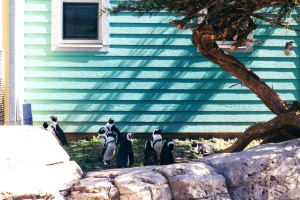Just 2.6 miles from UIS, the Henson Robinson Zoo traces its inception back to the vision of a notable Springfield resident, Henson C. Robinson. In 1967, the City of Springfield donated a parcel of land to the Springfield Park District to realize Robinson’s dream. Construction commenced in 1968, culminating in the official opening of the zoo on Aug. 29, 1970. Since its inception, the zoo has undergone significant growth and enhancement, welcoming numerous new animal species and expanding its array of exhibits.
 Open daily from 10 a.m. to 5 p.m., the zoo accommodates a diverse array of fauna originating from Australia, Africa and Asia as well as North and South America. Within its naturalistic enclosures, over 96 species of both indigenous and exotic animals reside. Among the notable inhabitants of the Henson Robinson Zoo are African Penguins, African Painted Dogs, Spider Monkeys, American Black Bears, Cougars, Sloth, Lemurs, Tortoise and much more!
Open daily from 10 a.m. to 5 p.m., the zoo accommodates a diverse array of fauna originating from Australia, Africa and Asia as well as North and South America. Within its naturalistic enclosures, over 96 species of both indigenous and exotic animals reside. Among the notable inhabitants of the Henson Robinson Zoo are African Penguins, African Painted Dogs, Spider Monkeys, American Black Bears, Cougars, Sloth, Lemurs, Tortoise and much more!
Beyond offering an enjoyable and educational atmosphere for visitors of all ages through activities such as the ZooLABS, where each 1.5 hour class includes behind-the-scenes learning and will feature live animals. These are great opportunities for kids to get up close and personal with animals with which the zoo actively engages in scientific research endeavors and conservation initiatives. With zoo classes, camps, volunteer programs, and on and offsite programming, the zoo provides fun, hands-on connections to the animal world. Moreover, it offers a variety of educational and conservation-oriented programs, as well as unique opportunities to discover more about animals, conservation, biodiversity and ecology.
 It’s crucial not only to explore zoos and gain insights into the natural world and animal habitats but also to value and support our local wildlife and natural surroundings.
It’s crucial not only to explore zoos and gain insights into the natural world and animal habitats but also to value and support our local wildlife and natural surroundings.
For those intrigued by zoos, animals and nature, a noteworthy recommendation is to explore the offerings of the Wildlife Prairie Park, close to Peoria. The Park provides a unique blend of experiences that differ from both traditional zoos to open-safari parks, primarily featuring regional and native species, diverging from the exotic animals commonly found in traditional zoo settings. I would also recommend exploring the Springfield Audubon Society, which provides visitors with walking trails and guided tours, emphasizing regional bird species and conservation initiatives.
Finally, if you’re interested in a safari-like experience, Aikman Wildlife Adventure is just 90 minutes from UIS. This destination offers an excellent opportunity to immerse yourself in a natural setting via its drive-thru path, allowing for a unique and immersive wildlife encounter.
By appreciating the inherent beauty surrounding us and understanding regional ecosystems, we can develop a deeper connection with nature, emphasizing the importance of conservation and stewardship. We should all act as caretakers of our planet, ensuring the preservation of its biodiversity for future generations to enjoy and learn from.




